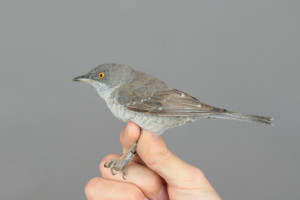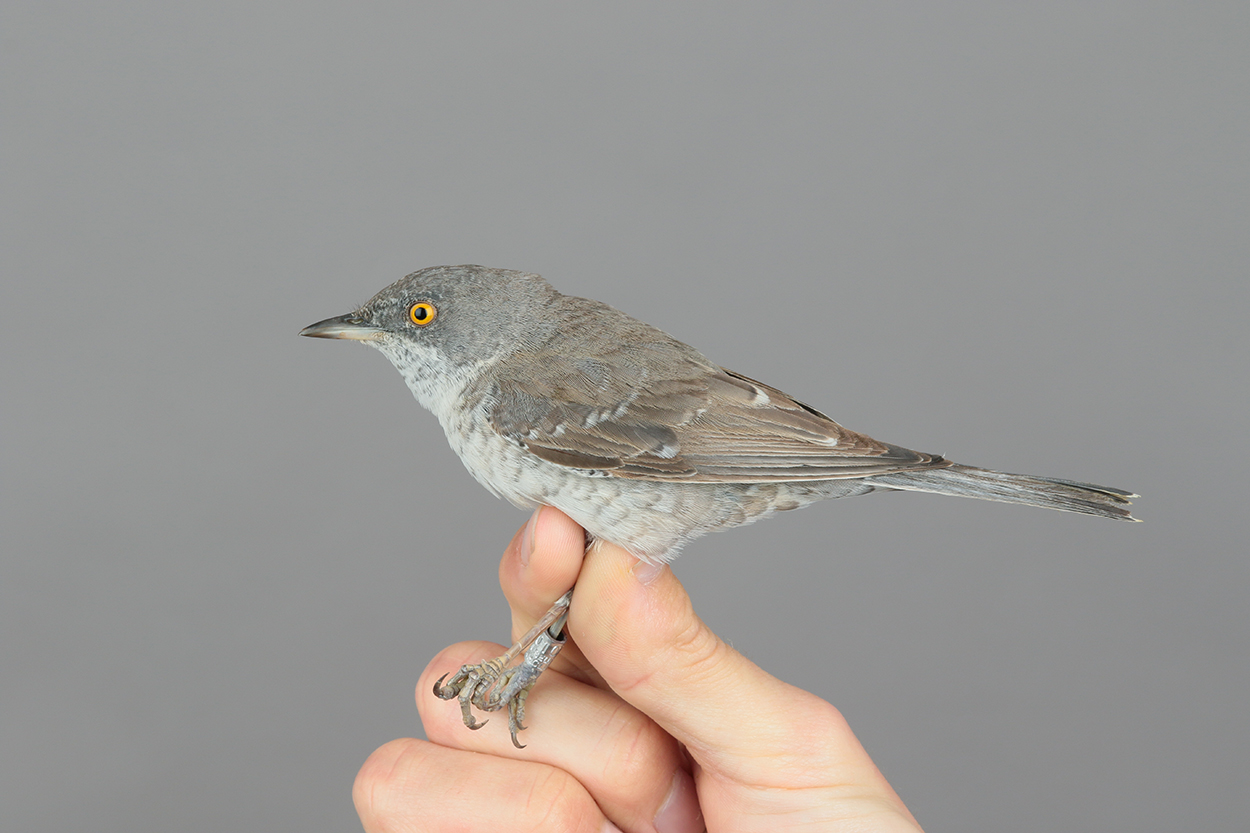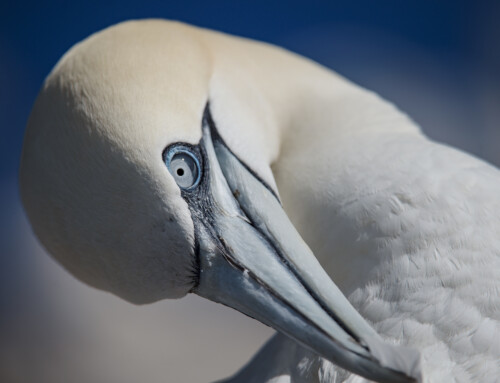LINKED PAPER
Seasonally divided moult in the Barred Warbler (Sylvia nisoria) is an endogenously controlled strategy. Hedenström, A., Åkesson, S., Bensch, S., Hasselquist & Lindström, Å. 2021 IBIS. doi: 10.1111/ibi.13001 VIEW

As ringers, we soon learn the importance of moult patterns in birds as key determinants of age. The Svensson ringers guide says that the following ‘SC’, ‘sp’, ‘WC’ and ‘wp’ are indicative of ‘Summer Complete’, ‘summer partial’, ‘Winter Complete’, and ‘winter partial’ moult, which can be used to determine the age of feather generations and thereby allowing the ringer to assign an appropriate age for the ringed bird. The age classes 1Y (first calendar year), 2Y (second calendar year), 3Y+ (third calendar year or older) can usually be distinguished depending on location, time of year and a species’ moult pattern. In the natural world moult patterns do not simply exist to aid ringers when ageing birds. Beside breeding and migration, moult constitutes one of the major life-history events of a bird’s annual cycle. However, compared with topics such as breeding ecology and bird migration, moult studies have received relatively little attention among ornithologists. As a young ringer during the 1980s, I was part of a group of students including Staffan Bensch, Dennis Hasselquist, Åke Lindström and Susanne Åkessson who spent lots of time at Ottenby Bird Observatory. There, we picked up the art of ageing birds based on moult patterns and became interested in the intriguing variation of moult among species.
As a part of a study about fuelling for migration, we targeted songbirds breeding in the area just north of the bird observatory. The observatory is situated on the southernmost point of the island of Öland in the Baltic. This area harbours a stable population of Barred Warblers (Sylvia nisoria), a scarce species in Sweden restricted to the south-eastern coastline and islands in the Baltic. Over a short period of time, instead of handling the occasional bird captured in the regular trapping scheme at the observatory, we captured numerous birds spanning into double figures. In most birds, if not all, the secondaries were relatively fresh and in clear contrast to the primaries which were browner and more worn (see Fig. 1). From this we could infer that Barred Warblers mainly renew their secondaries in the winter, while primaries are replaced after breeding in late summer during the breeding areas. Adult birds had replaced on average five secondary feathers, while juveniles replaced around three secondaries in their first winter. From the fresh appearance of the new secondaries, we inferred that they are likely to renew shortly before the spring migration. It was thrilling to see the results about this new moult pattern that we coined “seasonally divided flight feather moult” published in a scientific journal (see Hasselquist et al. 1998). However, inferring on the basis of differential wear and colouration among feathers recorded in the summer season, definite proof of the existence of a winter moult should be obtained by direct observation focused on active moult during this period of the year.

Figure 1 An adult male Barred Warbler (Sylvia nisoria) captured at Ottenby Bird Observatory, southeast Sweden, during the spring. This individual has renewed the secondaries and tertials in the winter, contrasting against the browner and more abraded primaries that were renewed before the previous autumn migration (hence being about nine months old). The tertials appear browner than the secondaries, which is caused by them being more exposed to solar radiation.
To Africa
We had read the books by Reg Moreau on African avifaunas and Palaearctic migration systems, and the pioneering papers on migrants in East Africa by David Pearson and Graeme Backhurst. Through a combination of youthful boldness and adventurousness we contacted David Pearson, who was then teaching biochemistry at a university in Nairobi, who replied that he may know of a place in Kenya where wintering Barred Warblers could be found. In addition to that, Barred Warblers regularly showed up in the catches of migrants at Ngulia Lodge in Tsavo West, which meant that an expedition to Kenya could also take us to the place of our dreams (Pearson and Backhurst 1976). After having secured some travel funds we set out for East Africa in November 1989 in search for Barred Warblers.
David met us at the airport and after staying with him in Nairobi for a couple of days we left in his Toyota for Ngulia. Here, nocturnal migrants are attracted by a combination of floodlights and mist, sometimes allowing catches of big numbers in just a few nets. For a young ornithologist this experience was of course unparalleled, with a mix of migrants of oriental origin (for example Upcher’s Warbler Hippolais languida, Basra Reed Warbler Acrocephalus griseldis, White-throated Robin Irania gutturalis, Rufous-tailed Scrub Robin Cercotrichas galactotes, Roller Coracias garrulus) and many afrotrops. In the daytime migrating raptors could be seen from the terrace by the swimming pool. At Ngulia the birds are on passage migration and therefore usually not in active moult. As a result, the Barred Warblers encountered there had either not started moult (November) or completed moult at some locality further to the north (late December and January). The area that David had scouted as a potential wintering habitat for Barred Warblers consisted of bushland a number of kilometres east of the village Mtito Andei, situated between the two Tsavo parks. Hence, this was our next stop where we set up camp and cleared corridors for mist nets in the vegetation.
It didn’t take long before the first Barred Warblers were captured. To our great luck they were already actively moulting – secondaries! Perhaps not a discovery causing a scientific revolution but to us this really felt like a major discovery. We returned to the same site the following year and David collected additional data in the third year. The results were written up and published in IBIS (Lindström et al. 1993). It turned out that the moult occurred rather early in the winter, contrary to what we had inferred from the Swedish birds. Overall, the number of renewed secondaries agreed with our observations of the Ottenby birds. In summary, we could show that the entire tail is renewed in the winter (both juvenile and adult birds), while in the summer only some central tail feathers are renewed. Juvenile birds replace a few secondaries in the first winter, all tertials and two or three outer primaries. It is probably important for flight economy to have fresh outer primaries, especially for birds making their first spring migration. As adults, Barred Warblers renew all their secondaries, tail feathers and tertials (Lindström et al. 1993). Hence, to get the complete picture and correct timing of the winter moult, it proved essential to study it on a site in Africa.
To understand the extent and timing of moult in a species it is necessary to see moult as an integrated process of the annual cycle, together with its ecology, migration distance and strategy. There are species, such as the White Throat (Sylvia communis), where west European populations have Summer Complete while eastern icterops have Winter Complete, with intermediate populations showing seasonally divided moult similar to that of the Barred Warbler. To understand the adaptive significance of the great variation in moult patterns/strategies creates a great challenge for ornithologists. Happily, there are signs in the literature that the study of moult has left the scientific doldrums of descriptive stamp collection. In a recent paper Kiat and Izhaki (2021) challenged the notion that seasonally divided moult, as found in the Barred Warbler and a few other species, is an adaptive strategy. They argued that it is the consequence of time stress before the autumn migration. In the linked forum paper (see Hedenström et al. 2021), we argue why their conclusion is wrong and that seasonally divided moult should be considered an adaptive strategy, different from Summer Complete and Winter Complete moults. For those who wish to immerse themselves in the world of moult patterns I recommend the beautiful book by Jenni and Winkler (2020).
References
Bensch, S., Hasselquist, D., Hedenström, A. & Ottosson, U. 1991. Rapid moult among palaearctic passerines in West Africa – an adaptation to the oncoming dry season? Ibis 133: 47-52. VIEW
Ginn, H.B. & Melville, D.S. 1983. Moult in birds. BTO Guide 19. Tring: BTO.
Hedenström, A., Åkesson, S., Bensch, S., Hasselquist, D. & Lindström, Å. 2021. Seasonally divided moult in the Barred Warbler (Sylvia nisoria) is an endogenously controlled strategy. Ibis (in press). VIEW
Hasselquist, D., Hedenström, A., Lindström, Å. & Bensch, S. 1988. The seasonally divided flight feather moult in the Barred Warbler Sylvia nisoria: a new moult pattern for European passerines. Ornis Scandinavica 19: 280-286. VIEW
Jenni, L. & Winkler, R. 2020. Moult and ageing of European Passerines, 2nd edn. London: Helm.
Kiat, Y. & Izhaki, I. 2021. Split moult: time constraints or endogeneous strategy? Ibis 163: 526-548. VIEW
Lindström, Å., Pearson, D. J., Hasselquist, D., Hedenström, A., Bensch, S. & Åkesson, S. 1993. The moult of Barred Warblers Sylvia nisora in Kenya – evidence for a split wing.-moult pattern initiated during the birds’ first winter. Ibis 135: 403-409. VIEW
Pearson, D.J. & Backhurst, G.C. 1976. The southward migration of Palaearctic birds over Ngulia, Kenya. Ibis 118: 78-105. VIEW
Image credit
Top right: Barred Warbler (Sylvia nisoria) © Ottenby Bird Observatory.
If you want to write about your research in #theBOUblog, then please see here.



